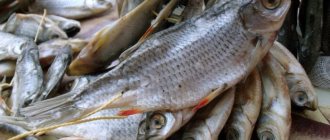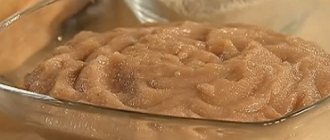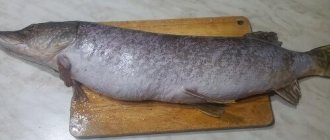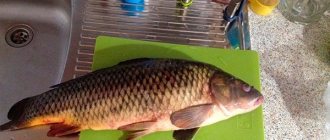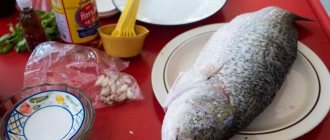Content
- How to dry fish at home
- How long to keep fish in salt before drying
- How long does it take to dry fish?
- How to persuade your wife to dry fish in the apartment?
- How to check dried fish for doneness?
- Video: How to dry fish at home
- What recipes do you know?
Striped robbers? Pike? Good pike perch? It doesn’t matter what you caught, what’s important is that if you decide to take your catch home with you, what should you do with it? Today we will tell you what to do with it, and how to do it without smelling so that your wife doesn’t kick you out of the house.
Storing dried fish
Any dried fish will dry out and become dried out over time, but this is not the only problem. When storing fish in conditions with access to light and air, salt is released on its surface, its fat oxidizes, the fish “rusts” and goes rancid. In conditions of high humidity, there is a risk of fish spoilage due to mold and the development of dangerous bacteria.
It is almost impossible to create ideal conditions for storing fish at home, but it is possible to preserve dried fish for a long time. For those who love dried fish, drying out is not a problem at all.
There are several types of storage of dried fish, each of which has its own pros and cons, and shelf life.
Package
Wooden boxes, corrugated cardboard boxes, wicker baskets, linen and multi-layer paper grocery bags, kraft paper laminated with polyethylene, etc. are used as packaging for storing dried fish.
Studies of different types of packaging have shown that polyethylene bags and aluminum foil laminated with polyethylene are unsuitable, while kraft paper with one-sided polyethylene coating passed the test.
Storing dried roach in laminated kraft bags at a temperature of about 0 degrees showed that the product, after 6 months, retains an attractive appearance, normal meat consistency, pleasant smell and taste.
Normal storage
The fish is stored at room temperature, in a corrugated cardboard box or paper packaging of several pieces. Without much damage to the properties of the fish, it can be stored for a week. If stored in this way for a longer period of time, the fish gradually dries out.
Longer storage is possible using a refrigerator. Humidity and temperature in the refrigerator compartment are optimal. The fish is packaged in paper bags of several pieces and can be stored in this form for up to a month.
Over time, the fish dries out and the fat oxidizes, so other methods are used for long-term storage.
Long-term storage
Long-term storage of dried fish is achieved in the following ways:
- Packing fish with a vacuum packer ensures storage in the refrigerator for up to six months;
- In glass containers without air – up to 10 months;
- At negative temperatures in the freezer - for 12 months.
To vacuum pack fish you need a kitchen packer. These devices are now quite affordable, but if you don’t have it, you can use other methods.
In the bank
Many fishermen practice storing dried fish in a glass jar. This is done as follows:
- Dried fish is tightly loaded into a suitable sized jar;
- A piece of a small candle is placed inside the container and lit;
- While the candle is burning, the jar is hermetically sealed with a metal lid;
- As the air burns out, the candle goes out - the fish is ready for storage.
In the freezer
Storing dried fish in the freezer is the easiest way to store it for long periods of time. Packed in plastic or paper bags, fish can be stored for a whole year.
As needed, the fish is removed and defrosted at room temperature for 15-30 minutes. The taste of dried fish is preserved and is almost no different from freshly removed from the dryer.
In brine
As we mentioned above, fish can be stored for a long time in the brine in which it is salted. There should be quite a lot of salt, and the fish should be in the refrigerator or cellar. As needed, the required amount of fish is removed, soaked and hung out for drying.
How to dry fish at home
Friends, first of all, after you have caught perch or other fish for drying, you must not only determine the place where all this action will unfold, but also prepare in advance what will help. Otherwise, you may get not only a low-quality product, but also problems from your wife (since the unpleasant smell will spread at a catastrophic speed).
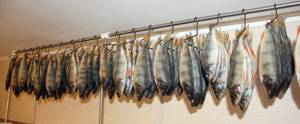
That is why we have prepared this article in which we will talk about each individual stage. From preparing the “tools” and salting, to checking the readiness of the fish.
Salting in brine
To salt fish in brine, you do not need to prepare a special brine; the juice released from the fish will be quite sufficient.
- The bottom of the container in which the fish will be salted is sprinkled with a layer of salt;
- The fish is placed sideways, in layers, each layer of fish is sprinkled with salt;
- The top layer of fish is completely covered with salt, covered with a lid on which a small weight is placed.
The weight is necessary so that when the brine is released, all the fish are immersed in it.
Immediately after salting, the fish is put into a cellar or refrigerator and salted there for 2-8 days, depending on the size of the fish.
How long to keep fish in salt before drying
In order to correctly answer this question, we will first consider step by step the instructions, which are recognized as the simplest and most accessible, without frills, subtleties and super secrets.

- We gut it, be sure to remove the gills. As some experts assure, this should only be done with large fish; this does not apply to small fish.
- Select a container for pickling. Any wooden tray or plastic bath, for example, a children's bath, will do.
- The prepared fish is rubbed with salt on all sides. This should be done against the scales.
- Pour salt into the selected container, on top of which we place the carcasses. The very first layer is the largest carcasses.
- Cover the whole thing with cloth or gauze on top. So that there are no parasites.
- We get it in 2-3 days.
So, in fact, we answered the question - how long to salt fish for drying.
Trout
- Time: 3 days.
- Number of servings: 10 persons.
- Calorie content of the dish (100 g): 186 kcal.
- Purpose: snack.
- Cuisine: Russian.
- Difficulty: easy.
This red fish, which belongs to the salmon family, can be used to make an original delicacy. It is often prepared for some important event: New Year, wedding. All kinds of salads and savory snacks are made with the addition of trout. In addition, it is delicious to eat simply with bread: make beautiful sandwiches and canapés. The most important thing to create a delicacy is to purchase high-quality fillet. It is advisable that it be chilled.
- medium-sized trout – 1 kg;
- salt - 4 tbsp. l.;
- sugar – 2 tbsp. l.;
- lemon juice – 2 tbsp. l.;
- black pepper - optional.
- Cut the fillet. The size of the pieces should be approximately 10 cm. Rub them with lemon juice, pepper, and sugar. The pieces are placed in a container between layers of salt and pressed on top with something heavy. Refrigerate the trout for 2 days.
- Dry the salted trout in the oven with the door open for 4-5 hours. Determine its readiness by looking at the backs. They must be dry.
- Before serving, the salted fish is cut into thin plastic pieces. When doing this, guide the knife at an acute angle.
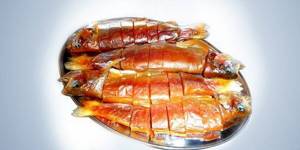
How long does it take to dry fish?
First, before you find out the answer to this question, let's take a closer look at the entire process of “cooking” dried fish. From the selection of necessary materials to the right choice of location.
What do we need. First of all, a thin cord or twine. You can even use wire. To pass the selected type of cord through the heads of fish without any problems, you will need either a nail or an awl. By the way, don’t forget about matches or toothpicks, which you can use to open the fish from the inside for better ventilation.
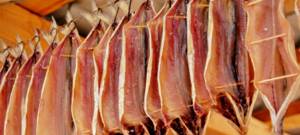
Where will we dry it? This is one of the main points, since this cannot be done everywhere. In general, there are three main requirements for a fish spawning site:
- During the day there should be shade there;
- Most of the time there is a draft;
- The place should be protected from rain and free of flies.
The ideal place is a summer veranda at the dacha. However, if there is no dacha, then as an option you can use a balcony or a non-residential room in the apartment. You can dry it on stretchers, as described above, or you can dry it on a clothes dryer or in a vegetable dryer. You can dry fish in the summer, but drying fish in the winter is also not a problem. The main thing is to correctly follow the step-by-step instructions.
Step-by-step instruction. Now let's get down to the process itself.
- Take the carcass and shake off the salt. To make it less salty (this is not for everybody), you can put it in boiling water for a couple of seconds.
- Using a cord or wire, depending on what you choose, we connect the fish through the eye sockets or through the gill slits. The main thing is that the fish is not placed tightly. This is necessary for free air circulation and water evaporation.
- We hang the “garlands” in the place that we have chosen in advance and cover them with gauze to prevent flies. Let me remind you that this is the simplest and most popular method. Some aesthetes sprinkle just a little vinegar so that it repels flies and wasps, which are drawn to salted fish like honey. But this is optional, you can limit yourself to just gauze.
How long to dry? And now to the main question - how long should the fish dry?
If you turn to the Internet, you can come across completely different terms, from 2-3 days to 2-3 weeks... The terms vary due to several parameters, such as size, salting period, fat content, etc. However, the most important parameter, as experts say in this matter, is heat. Drying on it is strictly not recommended. Since the meat will be dry, hard and unpleasantly bitter. That's why they try to find a middle ground.
Basic preparation steps
The cooking process includes:
- Treatment.
- Salting.
- Soaking.
Pickling
There are three main ways to salt fish:
- dry;
- wet;
- brine.
Dry pickling
The dry method is most often used when salting trophies weighing more than one kilogram, namely:
- pike;
- carp;
- bream and other large fish.
For dry salting you need to do this:
- Cut the carcasses along the ridge, remove the entrails, and spread them out.
- Salt the inside.
- Place the fish belly up in a wooden box.
- Sprinkle the scales with salt.
- Cover with film and press down with a weight.
- Leave the box in a cool place for a period of three to seven days.
This method can also be used to salt small fish without gutting it.
Wet salting
The wet method is used for carcasses weighing up to one kilogram. For salting you will need large enamel pans or plastic barrels.
This process includes steps:
- Clean the fish from dirt using a dry method.
- Remove entrails.
- Cover the bottom of the container with at least a few centimeters of salt.
- Arrange the carcasses so that the back of one overlaps the belly of the other, sprinkling with salt.
- Place the next layer of fish perpendicular to the previous one.
- Complete the installation and generously sprinkle the top layer with salt.
- Cover with a lid of smaller diameter and press down with a weight.
- After some time, after the juice has released and covers the fish, remove the container to a cool place.
- The readiness time depends on the size of the carcasses and is up to three days.
Salting in brine
This salting method works best for small fish weighing up to half a kilogram.
For this method you need:
- Prepare brine - add salt to water and stir thoroughly. Determine the concentration of the solution by dropping an egg into it; it should float up. Approximate ratio: three liters of water per kilogram of salt.
- Place the fish in the solution so that it covers it completely (approximate volume - 1 liter per 3 kilograms of raw material). It is more convenient to pre-string the carcasses on a rope and immerse them in the brine along with them.
- Cover with gauze and press down with a weight.
- Let stand for three days in a cool place.
Vladimir Plisov shares his video recipe for salting large river fish.
Soaking
Before drying, the fish is soaked in order to remove excess salt from the carcasses and desalinate the surface. This is necessary so that the finished product does not become soggy and is tasty.
To do this you should:
- Remove the fish from the brine and let it rest so that the salt is evenly distributed throughout the carcass.
- Rinse the fish thoroughly in running fresh water and remove any mucus from it.
- Place the carcasses in a container and fill them with cold water, changing it periodically. (The soaking time is equal to the salting time; readiness can be determined by the floating carcasses).
- Wipe the fish dry and place it on paper to drain excess liquid.
Drying
The final step is hanging the carcass for further drying.
You can do this in two ways:
- The fish is suspended by the tail - to do this, you need to make a hole in the area of the rear fin through which the wire is threaded. The bundles are then hung in a ventilated place. In this position, excess moisture and stomach contents will flow out through the mouth, therefore, the finished product will not have a bitter taste.
- The fish is suspended by the head - for this, a wire or rope is threaded through the eye holes. Fat and bile will remain inside and saturate the meat, it will become softer and have a slight bitterness.
General rules for drying fish:
- hang carcasses on stainless steel wire or fine weaving rope;
- the workpieces should not touch each other;
- fagots are hung in a small draft in the shade;
- for better drying, you can hang the carcasses in direct sunlight for 3-5 hours;
- if the weather is humid and not warm enough, large fish need to cut the belly, open it and insert “spacer sticks” there;
- Complete drying time in good, non-humid weather is three to five days.
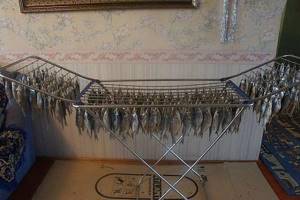
In the apartment
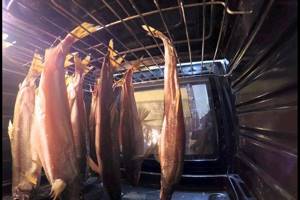
In the oven

In an electric dryer
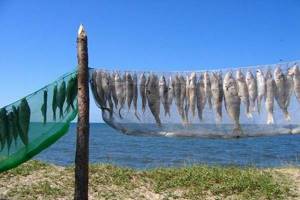
Outdoors
On open air
Features of drying fish in the open air:
- the procedure is carried out in sunny weather at a temperature of 18-20°C;
- bundles are placed on horizontal nets, slats, hung in open boxes or under a canopy;
- in rainy weather they hide it under an awning or indoors.
On the balcony
Ventilated balconies are suitable for drying catch, especially in cloudy and cold weather.
We dry the fish on the balcony like this:
- We cover the floor in the room.
- We place the basin under the hung seafood so that the leaking fat does not stain the room.
- Open the windows slightly to allow air circulation.
In the room
Drying fish at home is not the best option due to the specific smell. In an apartment, the fagots can be hung next to the heating device (in the winter season), placing a fan nearby, or the carcasses can be placed above the gas stove.
In the cellar
The cellar is suitable for drying small fish, but most likely it will have to be brought to the desired condition in a warmer place. Large seafood dries more slowly and will go rancid before it dries well.
In the cellar, due to the low temperature, drying can take up to two to three weeks.
In the attic
Advantages of drying in the attic:
- the roof gets very hot, drafts will speed up drying;
- neither sun nor rain will hit the carcasses;
- There is always enough space under the roof.
The main rule is to hang the bundles higher.
In the oven
Drying in the oven goes like this:
- Place the salted fish in rows on the grill. Place a baking sheet down or line with aluminum foil.
- Set the temperature to about 80°C (not higher) so that you don’t end up with just baked fish. Open the oven door 5-7 cm.
- The fish should dry for two hours, then cover the heads with heat-resistant foil and leave for another 4-6 hours.
- Hang and dry for a few more days.
In an electric dryer
Any convection electric dryer with a heat shut-off function is suitable for drying. A built-in fan will ensure air circulation.
The temperature should be about 30°C, otherwise the fish will steam and begin to fall apart. Depending on the size, the process will take from 2 to 4 days.
How to persuade your wife to dry fish in the apartment?
If you don’t have a summer house, don’t have a balcony, but have a lot of perch that you want to dry - dry it! Just make an agreement with your wife in advance. We are not calling for stretching “garlands” throughout the apartment, but you can highlight a corner... A small one... The main thing here is diplomacy. Therefore, here are some pros for drying your fish.
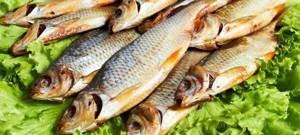
- Dried fish is a rich source of calcium, and many articles have been written about its benefits.
- Omega-3 acid found in fish can lift not only men but also women out of depression.
- According to French scientists, dried fish helps improve memory, still thanks to Omega-3 acid.
- The same scientists published a report that eating dried fish will help avoid the occurrence of many cardiovascular diseases.
- And most importantly, dried fish is a delicious delicacy served with a foamy drink. Many people know about this.
Storage of the finished product
In general, dried fish requires certain storage conditions. So, it should not be left in a damp room, as it will quickly deteriorate. Dried fish loses nutritional value and taste. It is best to store it in a cool place that is well ventilated.
You can also take a large jar and put fish and a burning candle in it. Then you need to close the container and wait until the candle goes out. This method makes it possible to preserve all the beneficial properties of fish for several months. The best option is to store fish in a tin can. In any case, everyone chooses the option that suits them best.
These were simple recommendations on how to properly dry fish so that it turns out tasty and nutritious. Today there are many recipes on how to do this. Let's consider the simplest of them.
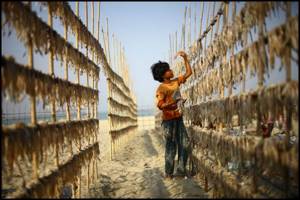
What recipes do you know?
Dear fishermen, in this article we looked at the simplest and most accessible option. However, we all know that there are much more similar tips and nuances! Therefore, we invite you to share your observations on this matter, and perhaps your personal experiences, in the comments under this article. By the way, you can talk about recipes for smoking fish, since this is also one of the ways to prepare the catch. Cold or hot smoked fish, it doesn’t matter. The main thing is the desire to share personal experience with fellow hobbyists.
